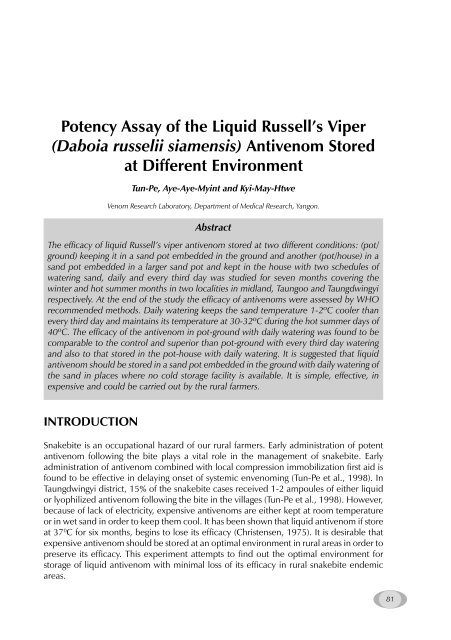Management of Snakebite and Research Management of Snakebite ...
Management of Snakebite and Research Management of Snakebite ...
Management of Snakebite and Research Management of Snakebite ...
You also want an ePaper? Increase the reach of your titles
YUMPU automatically turns print PDFs into web optimized ePapers that Google loves.
Potency Assay <strong>of</strong> the Liquid Russell’s Viper<br />
(Daboia russelii siamensis) Antivenom Stored<br />
at Different Environment<br />
Tun-Pe, Aye-Aye-Myint <strong>and</strong> Kyi-May-Htwe<br />
Venom <strong>Research</strong> Laboratory, Department <strong>of</strong> Medical <strong>Research</strong>, Yangon.<br />
Abstract<br />
The efficacy <strong>of</strong> liquid Russell’s viper antivenom stored at two different conditions: (pot/<br />
ground) keeping it in a s<strong>and</strong> pot embedded in the ground <strong>and</strong> another (pot/house) in a<br />
s<strong>and</strong> pot embedded in a larger s<strong>and</strong> pot <strong>and</strong> kept in the house with two schedules <strong>of</strong><br />
watering s<strong>and</strong>, daily <strong>and</strong> every third day was studied for seven months covering the<br />
winter <strong>and</strong> hot summer months in two localities in midl<strong>and</strong>, Taungoo <strong>and</strong> Taungdwingyi<br />
respectively. At the end <strong>of</strong> the study the efficacy <strong>of</strong> antivenoms were assessed by WHO<br />
recommended methods. Daily watering keeps the s<strong>and</strong> temperature 1-2ºC cooler than<br />
every third day <strong>and</strong> maintains its temperature at 30-32ºC during the hot summer days <strong>of</strong><br />
40ºC. The efficacy <strong>of</strong> the antivenom in pot-ground with daily watering was found to be<br />
comparable to the control <strong>and</strong> superior than pot-ground with every third day watering<br />
<strong>and</strong> also to that stored in the pot-house with daily watering. It is suggested that liquid<br />
antivenom should be stored in a s<strong>and</strong> pot embedded in the ground with daily watering <strong>of</strong><br />
the s<strong>and</strong> in places where no cold storage facility is available. It is simple, effective, in<br />
expensive <strong>and</strong> could be carried out by the rural farmers.<br />
INTRODUCTION<br />
<strong>Snakebite</strong> is an occupational hazard <strong>of</strong> our rural farmers. Early administration <strong>of</strong> potent<br />
antivenom following the bite plays a vital role in the management <strong>of</strong> snakebite. Early<br />
administration <strong>of</strong> antivenom combined with local compression immobilization first aid is<br />
found to be effective in delaying onset <strong>of</strong> systemic envenoming (Tun-Pe et al., 1998). In<br />
Taungdwingyi district, 15% <strong>of</strong> the snakebite cases received 1-2 ampoules <strong>of</strong> either liquid<br />
or lyophilized antivenom following the bite in the villages (Tun-Pe et al., 1998). However,<br />
because <strong>of</strong> lack <strong>of</strong> electricity, expensive antivenoms are either kept at room temperature<br />
or in wet s<strong>and</strong> in order to keep them cool. It has been shown that liquid antivenom if store<br />
at 37 0 C for six months, begins to lose its efficacy (Christensen, 1975). It is desirable that<br />
expensive antivenom should be stored at an optimal environment in rural areas in order to<br />
preserve its efficacy. This experiment attempts to find out the optimal environment for<br />
storage <strong>of</strong> liquid antivenom with minimal loss <strong>of</strong> its efficacy in rural snakebite endemic<br />
areas.<br />
81









